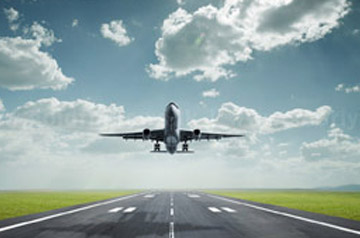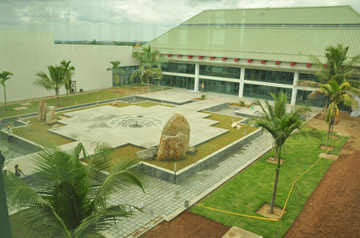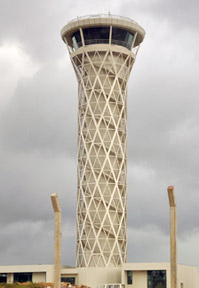Lanka's aviation service marks milestone
by P. Krishnaswamy
The Sri Lankan aviation service that was started in 1912, in a
historically significant point of time, marks its 101st anniversary
today.
 |
| Taking off |
 |
| Mattala
Airport Terminal Building |
|

Mattala Airport Control Tower |
On a bright morning in December 1912 , two Frenchmen, Georges
Verminch and Marc Pourpre, managed to take-off in the Bleriot aircraft
at the Colombo Race Coursed grounds , fly and land safely thus recording
the 'First Flight' in the skies of Sri Lanka. The aircraft had an Anzani
25 horse power engine and was built in France. The aeroplane was rated
as the best flying machine in the world, after Louis Bleriot flew it
across the English Channel from Calais to Dover on July 25, 1909. The
Bleriot aircraft did not fly during the first few months after its
arrival in Sri Lanka. It had been exhibited in different locations and
people had bought tickets to see the wonder machine that was capable of
travelling in air.
Today, the Sri Lankan Airlines owns 21 aircraft , including seven A
330 200 and eight A3 320 200 , and operates services to most of the
world destinations. In the ancient times Ussangoda in Ambanlantota - the
present Hambantota - was landing pad of King Ravana's flying craft
'Dandu Monara' (the peacock chariot') , according to Hindu mythology.
Under President Mahinda Rajapaksa's long-cherished ambition and vision
Hambantota now has the Mattala Rajapaksa International Airport (MRIA).
The airport, declared open by the President on March 18, 2013 is the
newest and most developing airport in Sri Lanka and also the first
greenfield airport. It has the capacity to annually handle 150,000
tonnes of cargo and 45,000 aircraft movement, its infrastructure
facilities include 20 parking bays and 15 aero bridges.
The prestigious aviation service of Sri Lanka has many achievements
to its credit. The Air Ceylon achieved the distinction of one of the
world's safest airlines, never recording a single passenger fatality
throughout its 32-year history, apart from an accident on 21 December
1949 in which Douglas C-47 Dakota (registered VP-CAT) was damaged beyond
repair in a crash landing at Tiruchirapalli Airport following a
scheduled passenger flight from Jaffna. The 21 passengers and three crew
members survived the accident. Air Lanka was set up by the Government of
Sri Lanka in July 1979 following the closure of Air Ceylon in 1978.
In 1947, the Government purchased three war-surplus Douglas DC 3
Dakota aeroplanes. The DC-3s were all named after queens Sita Devi,
Viharamaha Devi and Sunethra Devi a tradition which continued for some
years. But the birth of the new State airline was still a few months in
the future. So the three aircraft, under the aegis of the Civil Aviation
Department, were extensively used for pilot training and route proving
duties. In June 1947, at the suggestion of Sir John Kotelawala,
Viharamaha Devi flew to London to collect a valuable cargo of electoral
registers for the coming elections.
During its life span from 1947 to 1978, Air Ceylon entered into
partnership with four international airlines viz. Australian National
Airways (ANA), KLM Royal Dutch Airlines, British Overseas Airways
Corporation (BOAC) and French airline UTA. Becoming Air
Ceylon's fourth international partner in 25 years, UTA provided a
Douglas DC-8 jet for the long-haul services. Originally operated by UTA
pilots with Sri Lankan cabin attendants, the DC-8 was subsequently
bought outright by Air Ceylon and flown with a 100 percent Air Ceylon
crew. This purchase was applauded as a breakthrough in Air Ceylon's
struggle to shed the shackles of foreign influence. Air Ceylon had, at
last, come of age. As the last of the airline's faithful DC-3s were
phased out, a second Avro HS 748 was bought.
However before long, the first signs began emerging that all was not
well with the national carrier. Authorities in Europe impounded a DC-8
for non-payment of fuel bills, and staff morale plummeted when
international services were suspended towards the end of 1977. A reduced
domestic and regional operation soldiered on valiantly with the Trident
and two Avros.
On September 7, 1978, Air Ceylon suffered a cruel blow. One of the
Avros, just back from a trip to Jaffna, which parked at Ratmalana was
exploded by a bomb planted inside aircraft, reducing it to a charred,
twisted hulk.
Miraculously no lives were lost. The surviving Avro and Trident
struggled to maintain a semblance of an operation.The airline's golden
aircraft was the Lockheed L1011 Tristar, which served the airline from
1980 to 2000. Air Lanka, which was state-owned, was part-privatized to
the Dubai-based Emirates Group in 1998, when Emirates and the Sri Lankan
Government signed an agreement for a ten-year strategic partnership. The
management contract between Emirates and the Sri Lanka Government
expired on March 31 2008. Emirates sold its stake in shares to the
Government of Sri Lanka at US$ 53 million in 2010, thus ending any
affiliations the two airlines had with. The airline joined the one world
alliance in 2012. Mihin Lanka which was incorporated on October 27 2006
is a low-fare airline based in Colombo, Sri Lanka. It is wholly owned by
the Sri Lankan government and commenced operations on 24 April 2007. The
airline operates scheduled flights from its hub at Bandaranaike
International Airport to a number of cities in the Indian subcontinent,
the Gulf States and Southeast Asia. It code-shares with its partner
SriLankan Airlines on several routes, as part of a consolidation
exercise between the two airlines.
In response to a recommendation made by the International Civil
Aviation Organisation for enhancement of the State's capability to
conduct Safety Oversight functions, the Government abolished the
Department of Civil Aviation in 2002 and created Civil Aviation
Authority of Sri Lanka in terms of Civil Aviation Authority of Sri Lanka
Act No.34 of 2002.
The Government created an Airport Authority in 1979 for the
development, operation and maintenance of civil airports in Sri Lanka
and it survived only for three years. In 1983, the Government created an
Agent established under the Companies Act to succeed the Airports
Authority and to also provide Air Traffic Services which were hitherto
handled by the Department of Civil Aviation. The Agent was identified as
the Airports and Aviation Services (Sri Lanka) Ltd., which has later
being identified as the Statutory Service Provider. Under the Civil
Aviation Act. Katunayake International Airport was developed under the
Canadian Government's assistance in 1963. With the development work was
completed in 1968, International air transport operations were shifted
from Ratmalana to Katunayake. The airport had a passenger handling
capacity of 1.5 million per annum at the beginning and it was
subsequently expanded to 6 million passenger per annum with one pier and
connecting eight aerobridges, under the Stage I-Phase II of the Airport
Development Program which was completed in November 2005. |

